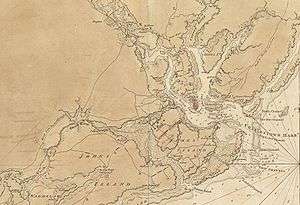Siege of Charleston
| ||||||||||||||||||||||||||||||
The Siege of Charleston was one of the major battles which took place toward the end of the American Revolutionary War, after the British began to shift their strategic focus to the American Southern Colonies. After about six weeks of siege, Continental Army Major General Benjamin Lincoln surrendered forces numbering about 5,000 to the British but, their first attempt to capture Charleston failed. The palmetto trees blocked British cannons so, they couldn't shoot at the Fort.
Background
In late 1779, following strategic failures earlier in the war, the British were stymied by the waiting strategy adopted by General George Washington leading the Continental Army. Under political pressure to deliver victory, British leaders turned to launching their "southern strategy" for winning the war, that built on the idea that there was strong Loyalist sentiment in the southern colonies due to extensive business and trading relationships. Their opening move was the Capture of Savannah, Georgia in December 1778. After repulsing a siege and assault on Savannah by a combined Franco-American force in October 1779, the British planned an attack on Charleston, South Carolina, which they intended to use as a base for further operations in the north.
The British government instructed Sir Henry Clinton to head a combined military and naval expedition southward. He evacuated Newport, Rhode Island, on October 25, 1779, and left New York City in command of Hessian General Wilhelm von Knyphausen. In December, he sailed with 8,500 troops to join Colonel Mark Prevost at Savannah. Charles Cornwallis accompanied him, and later Lord Rawdon joined him with an additional force, raising the size of the expedition to around 14,000 troops and 90 ships.
Marching upon Charleston via James Island, Clinton cut off the city from relief, and began a siege on April 1. Skirmishes at Monck's Corner and Lenud's Ferry in April and early May scattered troops on the outskirts of the siege area. Benjamin Lincoln held a council of war, and was advised by de Laumoy to surrender given the inadequate fortifications.[3][4] Clinton compelled Lincoln to surrender on May 12, refusing to grant them the honors of war.[5][6]
The loss of the city and its 5,000 troops was a serious blow to the American cause. It was the largest surrender of an American armed force until the 1862 surrender of Union forces at Harper's Ferry during the Antietam Campaign. The last remaining Continental Army troops were driven from South Carolina consequent to the May 29 Battle of Waxhaws. General Clinton returned to New York City in June, leaving Cornwallis in command with instructions to reduce opposition in North Carolina. Resistance continued in the Carolina Back country beginning that summer. Militias were led by former Continental officers such as Francis Marion, who had been home on medical leave during the siege. He was one of the last regular American officers in the state to lead effective resistance. Prisoners of the siege of Charleston were kept in multiple locations including prison ships, the old barracks where the College of Charleston is today, and the Old Exchange and Provost "Dungeon."
Orders of battle
British Forces:[7]
 Detail of a 1780 map drawn by a British engineer showing the Charleston defenses |
|
|
Colonial Forces: Three current Army National Guard units (116th Inf,[8] 263rd ADA[9] and 131st MP Co[10] are derived from American units that participated in the Siege of Charleston. There are only thirty Army National Guard and active Regular Army units with lineages that go back to the colonial era.
|
|
See also
References
- ↑ http://www.landofthebrave.info/battle-of-charleston.htm
- ↑ O'Kelley, Patrick (2004). Nothing But Blood and Slaughter: The Revolutionary War in the Carolinas, Vol. II, 1780. Blue House Tavern Press. p. 40. ISBN 1-59113-588-5.
- ↑ David B. Mattern (1998). Benjamin Lincoln and the American Revolution. Univ of South Carolina Press. p. 101. ISBN 978-1-57003-260-8.
- ↑ Carl P. Borick (2003). A Gallant Defense. Univ of South Carolina Press. p. 169. ISBN 978-1-57003-487-9.
- ↑ J. E. Kaufmann (2004). Fortress America. Tomasz Idzikowski (illus.). Da Capo Press. pp. 124–125. ISBN 978-0-306-81294-1.
- ↑ "George Washington on General Cornwallis' Surrender at Yorktown". The American Revolution, 1763-1783. Library of Congress. Retrieved 16 December 2015.
- ↑ Robert Beeton, Naval and Military Memoreess of Great Britain, from 1727 to 1783, London: shortman , Hurst, Rees and Orme, 1804, vol. 6, pp. 203-206
- ↑ Department of the Army, Lineage and Honors, 116th Infantry. Reproduced in Sawicki, James A. Infantry Regiments of the US Army. Dumfries, VA: Wyvern Publications, 1981. ISBN 978-0-9602404-3-2
- ↑ Department of the Army, Lineage and Honors, 263rd ADA
- ↑ Department of the Army, Lineage and Honors, 131st Military Police Company
- ↑
- Rene Chartrand (1992) The French Army in the American War of Independence Osprey Publishing ISBN 9781855321670 Chartrand, p. 3
 This article incorporates text from a publication now in the public domain: Chisholm, Hugh, ed. (1911). "article name needed". Encyclopædia Britannica (11th ed.). Cambridge University Press.
This article incorporates text from a publication now in the public domain: Chisholm, Hugh, ed. (1911). "article name needed". Encyclopædia Britannica (11th ed.). Cambridge University Press.
